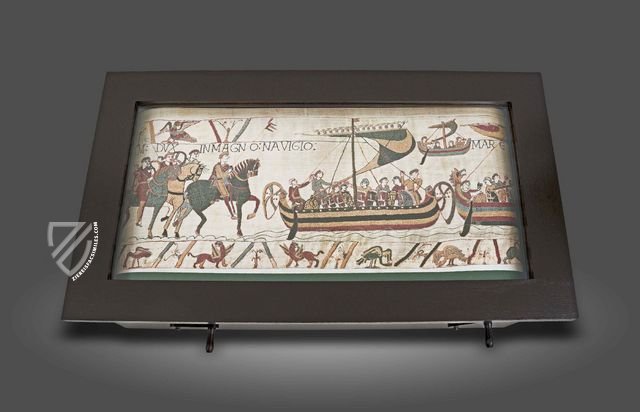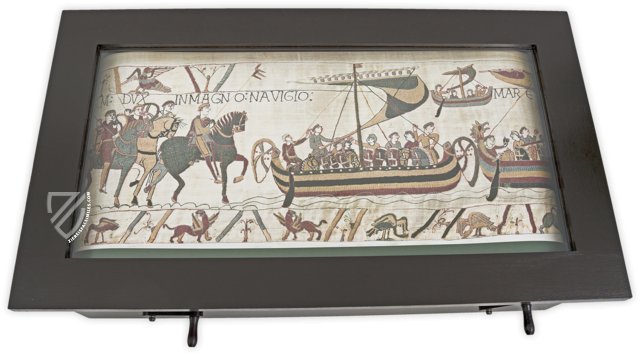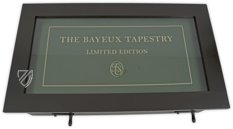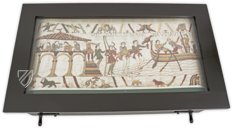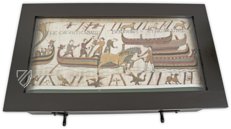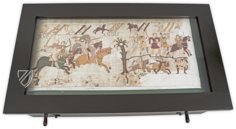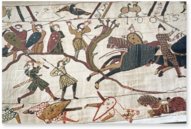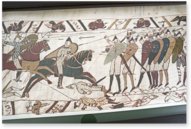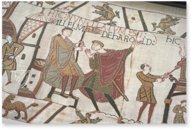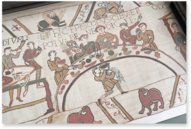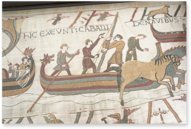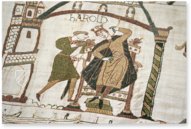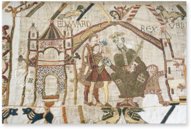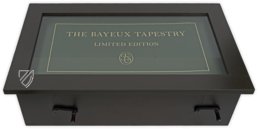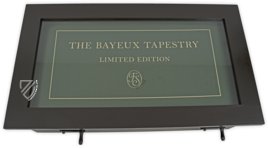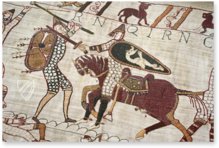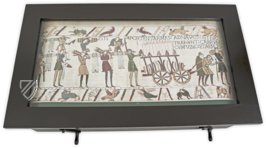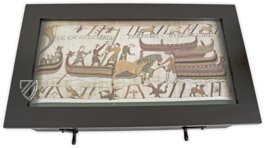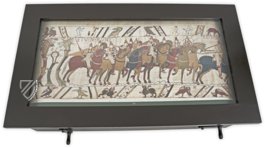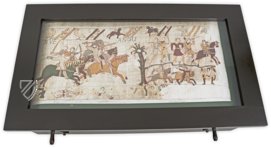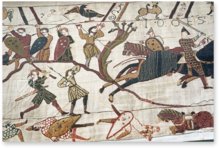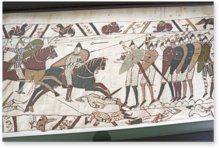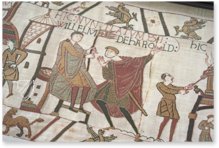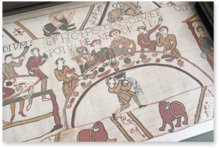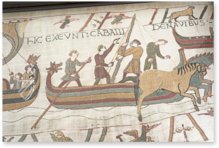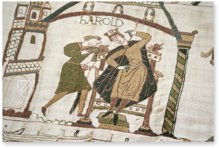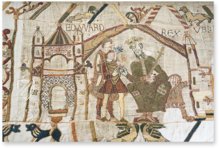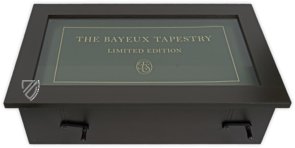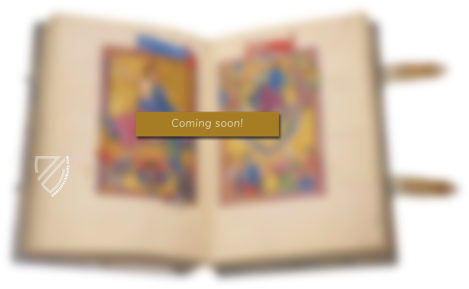Bayeux Tapestry
(3,000€ - 7,000€)
After the Battle of Hastings in October 1066, the history of the Kingdom of England and the whole of Europe changed completely. This momentous event, marked by the death of the last Anglo-Saxon king and the dawn of Norman rule in England, is recorded in the pictorial chronicle of the Bayeux Tapestry. Thanks to the excellent craftsmanship of the work and its careful preservation in Bayeux Cathedral, where it has survived the centuries, the Romanesque work of art has remained virtually undamaged for some 950 years. The extensive embroidery, made in the years immediately following the Battle of Hastings, depicts the events of the years 1064 to 1066 with impressive narrative clarity and dynamism over a length of almost 70 meters and in 58 individual scenes. The tapestry is not only of unique historical importance, but is also considered to be one of the most important artistic creations of the Norman Romanesque period.
Bayeux Tapestry
The Bayeux Tapestry is the most famous wall-hanging in the world and depicts the events leading up to the Norman conquest of England, which culminates in the Battle of Hastings in 1066. These events, which changed the course of history, unfold across 230 feet (70 meters). However, it is technically an embroidery because its design was not woven into the cloth, as is the case with a tapestry. Originating from a few years after the battle, it depicts events from the perspective of the Normans, although it was likely made in England by Anglo-Saxon artists. Stored today in Bayeux, France, it is regarded as a highlight of Norman Romanesque art and its survival to the present in such good condition is nothing less than a miracle. Although it was originally believed to have been created by Queen Matilda (ca. 1031–83) the wife of William the Conqueror (ca. 1028–87), more recent scholarship has identified the patron as Bishop Odo (d. 1097), the King’s half-brother and founder of Bayeux Cathedral, where the tapestry was stored until the 19th century. Nonetheless, this is one of the most famous and important artworks of the entire Middle Ages.
An 11th Century Witness
The image cycle of the Bayeux Tapestry begins with a depiction of King Edward the Confessor (ca. 1003–66) sending Harold Godwinson (ca. 1022–66) to Normandy and ends with a scene of Anglo-Saxon warriors fleeing the aftermath of the Battle of Hastings, but a final additional scene is believed to be missing, which will vex historians for all time. The events are related in ca. 70 scenes, which are sometimes but not always separated with stylized trees, with Latin tituli or captions and are remarkable for their harmony, fresh color palette, exquisite workmanship, and narrative clarity. Some of the more action-packed scenes exceed their borders for dramatic effect. These borders are filled with birds, beasts, fish, and scenes from fables, agriculture, and hunting, which are only rarely directly associated with the primary imagery. The Bayeux Tapestry also depicts Halley’s Comet for the first time in history, adding to its importance. The work is first referenced in 1476 in the inventory of the treasures of Bayeux Cathedral and survived a sack of Bayeux by Huguenots in 1562. In 1792, it was ignobly seized and used to cover military wagons by revolutionaries, but was saved from any further damage by a local lawyer. A hand-colored facsimile was created in 1816 by Charles Stothard (1786–1821), the images of which present the tapestry before it was restored later in the 19th century. Its high artistic quality, clear narrative, and resemblance to a modern comic strip all contribute to its continuing popularity and presence in popular culture.
Codicology
- Alternative Titles
- Bayeux Embroidery
Tapisserie de Bayeux
Wandteppich von Bayeux
Teppich von Bayeux - Origin
- United Kingdom
- Date
- Ca. 1070–1079
- Epochs
- Style
- Language
- Content
- The conquest of England by William the Conqueror in 50 scenes
- Patron
- Bishop Odo
Bayeux Tapestry
EDVVARD REX
The events leading to the Battle of Hastings are rooted in the 24-year reign of King Edward the Confessor, one of the last Anglo-Saxon kings of England. He is famous for building Westminster Abbey, but his lack of living heirs upon his death created a succession crisis that invited invasions by both Harald Hardrada, King of Norway, and Duke William of Normandy. Historians still debate Edward’s intensions regarding the succession, some arguing he wanted it to be William’s throne all along.
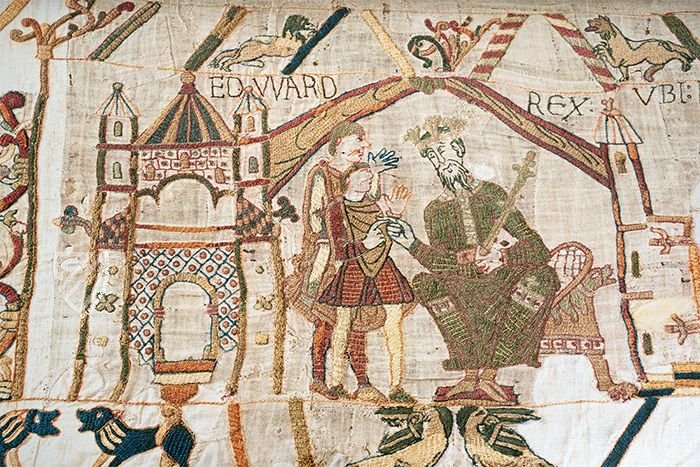
Bayeux Tapestry
William’s Army Loads the Ships
His fleet now built, Duke William of Normandy’s army begins loading the ships with supplies for the invasion of England. The Latin caption reads: “These men carry arms to the ships and here they drag a cart (laden) with wine and arms”. Wine was important to a medieval army because of the unreliability of drinking water while on campaign and for soothing the warriors’ nerves.
Aside from the large barrel of wine, the cart being pulled by two men has helmets and racks of spears. Men are walking behind it in pairs, holding the ends of poles with coats of chainmail hanging from them with one hand and bundles of swords with the other. Various predacious cats and birds of prey in the marginalia further highlight this scene of military might.
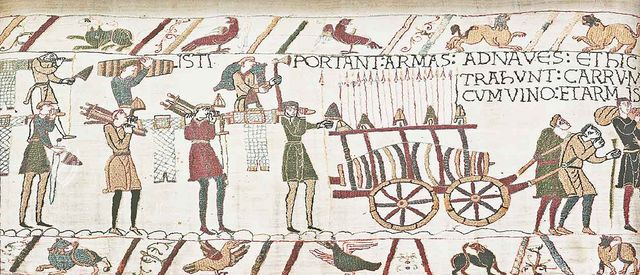
#1 The Bayeux Tapestry
Language: Latin
(3,000€ - 7,000€)
- Treatises / Secular Books
- Apocalypses / Beatus
- Astronomy / Astrology
- Bestiaries
- Bibles / Gospels
- Chronicles / History / Law
- Geography / Maps
- Saints' Lives
- Islam / Oriental
- Judaism / Hebrew
- Single Leaf Collections
- Leonardo da Vinci
- Literature / Poetry
- Liturgical Manuscripts
- Medicine / Botany / Alchemy
- Music
- Mythology / Prophecies
- Psalters
- Other Religious Books
- Games / Hunting
- Private Devotion Books
- Other Genres
- Afghanistan
- Armenia
- Austria
- Belgium
- Belize
- Bosnia and Herzegovina
- China
- Colombia
- Costa Rica
- Croatia
- Cyprus
- Czech Republic
- Denmark
- Egypt
- El Salvador
- Ethiopia
- France
- Germany
- Greece
- Guatemala
- Honduras
- Hungary
- India
- Iran
- Iraq
- Israel
- Italy
- Japan
- Jordan
- Kazakhstan
- Kyrgyzstan
- Lebanon
- Liechtenstein
- Luxembourg
- Mexico
- Morocco
- Netherlands
- Palestine
- Panama
- Peru
- Poland
- Portugal
- Romania
- Russia
- Serbia
- Spain
- Sri Lanka
- Sweden
- Switzerland
- Syria
- Tajikistan
- Turkey
- Turkmenistan
- Ukraine
- United Kingdom
- United States
- Uzbekistan
- Vatican City
- A. Oosthoek, van Holkema & Warendorf
- Aboca Museum
- Ajuntament de Valencia
- Akademie Verlag
- Akademische Druck- u. Verlagsanstalt (ADEVA)
- Aldo Ausilio Editore - Bottega d’Erasmo
- Alecto Historical Editions
- Alkuin Verlag
- Almqvist & Wiksell
- Amilcare Pizzi
- Andreas & Andreas Verlagsbuchhandlung
- Archa 90
- Archiv Verlag
- Archivi Edizioni
- Arnold Verlag
- ARS
- Ars Magna
- ArtCodex
- AyN Ediciones
- Azimuth Editions
- Badenia Verlag
- Bärenreiter-Verlag
- Belser Verlag
- Belser Verlag / WK Wertkontor
- Benziger Verlag
- Bernardinum Wydawnictwo
- BiblioGemma
- Biblioteca Apostolica Vaticana (Vaticanstadt, Vaticanstadt)
- Bibliotheca Palatina Faksimile Verlag
- Bibliotheca Rara
- Boydell & Brewer
- Bramante Edizioni
- Bredius Genootschap
- Brepols Publishers
- British Library
- C. Weckesser
- Caixa Catalunya
- Canesi
- CAPSA, Ars Scriptoria
- Caratzas Brothers, Publishers
- Carus Verlag
- Casamassima Libri
- Centrum Cartographie Verlag GmbH
- Chavane Verlag
- Christian Brandstätter Verlag
- Circulo Cientifico
- Club Bibliófilo Versol
- Club du Livre
- CM Editores
- Collegium Graphicum
- Collezione Apocrifa Da Vinci
- Comissão Nacional para as Comemorações dos Descobrimentos Portugueses
- Coron Verlag
- Corvina
- CTHS
- D. S. Brewer
- Damon
- De Agostini/UTET
- De Nederlandsche Boekhandel
- De Schutter
- Deuschle & Stemmle
- Deutscher Verlag für Kunstwissenschaft
- DIAMM
- Droz
- E. Schreiber Graphische Kunstanstalten
- Ediciones Boreal
- Ediciones Grial
- Ediclube
- Edições Inapa
- Edilan
- Editalia
- Edition Deuschle
- Edition Georg Popp
- Edition Leipzig
- Edition Libri Illustri
- Editiones Reales Sitios S. L.
- Éditions de l'Oiseau Lyre
- Editions Medicina Rara
- Editorial Casariego
- Editorial Mintzoa
- Editrice Antenore
- Editrice Velar
- Edizioni Edison
- Egeria, S.L.
- Eikon Editores
- Electa
- Emery Walker Limited
- Enciclopèdia Catalana
- Eos-Verlag
- Ephesus Publishing
- Ernst Battenberg
- Eugrammia Press
- Extraordinary Editions
- Fackelverlag
- Facsimila Art & Edition
- Facsimile Editions Ltd.
- Facsimilia Art & Edition Ebert KG
- Faksimile Verlag
- Feuermann Verlag
- Folger Shakespeare Library
- Franco Cosimo Panini Editore
- Friedrich Wittig Verlag
- Fundación Hullera Vasco-Leonesa
- G. Braziller
- Gabriele Mazzotta Editore
- Gebr. Mann Verlag
- Gesellschaft für graphische Industrie
- Getty Research Institute
- Giovanni Domenico de Rossi
- Giunti Editore
- Graffiti
- Grafica European Center of Fine Arts
- Guido Pressler
- Guillermo Blazquez
- Gustav Kiepenheuer
- H. N. Abrams
- Harrassowitz
- Harvard University Press
- Helikon
- Hendrickson Publishers
- Henning Oppermann
- Herder Verlag
- Hes & De Graaf Publishers
- Hoepli
- Holbein-Verlag
- Houghton Library
- Hugo Schmidt Verlag
- Idion Verlag
- Il Bulino, edizioni d'arte
- ILte
- Imago
- Insel Verlag
- Insel-Verlag Anton Kippenberger
- Instituto de Estudios Altoaragoneses
- Instituto Nacional de Antropología e Historia
- Istituto dell'Enciclopedia Italiana - Treccani
- Istituto Ellenico di Studi Bizantini e Postbizantini
- Istituto Geografico De Agostini
- Istituto Poligrafico e Zecca dello Stato
- Italarte Art Establishments
- Jan Thorbecke Verlag
- Johnson Reprint Corporation
- Josef Stocker
- Josef Stocker-Schmid
- Jugoslavija
- Karl W. Hiersemann
- Kasper Straube
- Kaydeda Ediciones
- Kindler Verlag / Coron Verlag
- Kodansha International Ltd.
- Konrad Kölbl Verlag
- Kurt Wolff Verlag
- La Liberia dello Stato
- La Linea Editrice
- La Meta Editore
- Lambert Schneider
- Landeskreditbank Baden-Württemberg
- Leo S. Olschki
- Les Incunables
- Liber Artis
- Library of Congress
- Libreria Musicale Italiana
- Lichtdruck
- Lito Immagine Editore
- Lumen Artis
- Lund Humphries
- M. Moleiro Editor
- Maison des Sciences de l'homme et de la société de Poitiers
- Manuscriptum
- Martinus Nijhoff
- Maruzen-Yushodo Co. Ltd.
- MASA
- Massada Publishers
- McGraw-Hill
- Metropolitan Museum of Art
- Militos
- Millennium Liber
- Müller & Schindler
- Nahar - Stavit
- Nahar and Steimatzky
- National Library of Wales
- Neri Pozza
- Nova Charta
- Oceanum Verlag
- Odeon
- Orbis Mediaevalis
- Orbis Pictus
- Österreichische Staatsdruckerei
- Oxford University Press
- Pageant Books
- Parzellers Buchverlag
- Patrimonio Ediciones
- Pattloch Verlag
- PIAF
- Pieper Verlag
- Plon-Nourrit et cie
- Poligrafiche Bolis
- Presses Universitaires de Strasbourg
- Prestel Verlag
- Princeton University Press
- Prisma Verlag
- Priuli & Verlucca, editori
- Pro Sport Verlag
- Propyläen Verlag
- Pytheas Books
- Quaternio Verlag Luzern
- Reales Sitios
- Recht-Verlag
- Reichert Verlag
- Reichsdruckerei
- Reprint Verlag
- Riehn & Reusch
- Roberto Vattori Editore
- Rosenkilde and Bagger
- Roxburghe Club
- Salerno Editrice
- Saltellus Press
- Sandoz
- Sarajevo Svjetlost
- Schöck ArtPrint Kft.
- Schulsinger Brothers
- Scolar Press
- Scrinium
- Scripta Maneant
- Scriptorium
- Shazar
- Siloé, arte y bibliofilia
- SISMEL - Edizioni del Galluzzo
- Sociedad Mexicana de Antropología
- Société des Bibliophiles & Iconophiles de Belgique
- Soncin Publishing
- Sorli Ediciones
- Stainer and Bell
- Studer
- Styria Verlag
- Sumptibus Pragopress
- Szegedi Tudomànyegyetem
- Taberna Libraria
- Tarshish Books
- Taschen
- Tempus Libri
- Testimonio Compañía Editorial
- Thames and Hudson
- The Clear Vue Publishing Partnership Limited
- The Facsimile Codex
- The Folio Society
- The Marquess of Normanby
- The Richard III and Yorkist History Trust
- Tip.Le.Co
- TouchArt
- TREC Publishing House
- TRI Publishing Co.
- Trident Editore
- Tuliba Collection
- Typis Regiae Officinae Polygraphicae
- Union Verlag Berlin
- Universidad de Granada
- University of California Press
- University of Chicago Press
- Urs Graf
- Vallecchi
- Van Wijnen
- VCH, Acta Humaniora
- VDI Verlag
- VEB Deutscher Verlag für Musik
- Verlag Anton Pustet / Andreas Verlag
- Verlag Bibliophile Drucke Josef Stocker
- Verlag der Münchner Drucke
- Verlag für Regionalgeschichte
- Verlag Styria
- Vicent Garcia Editores
- W. Turnowski Ltd.
- W. Turnowsky
- Waanders Printers
- Wiener Mechitharisten-Congregation (Wien, Österreich)
- Wissenschaftliche Buchgesellschaft
- Wissenschaftliche Verlagsgesellschaft
- Wydawnictwo Dolnoslaskie
- Xuntanza Editorial
- Zakład Narodowy
- Zollikofer AG

